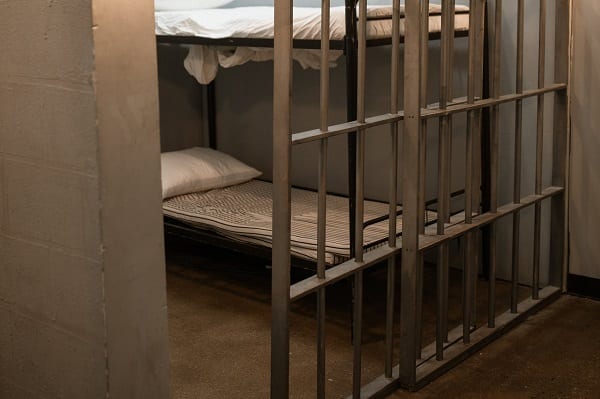BALTIMORE, MD—A Baltimore-area gang leader has been sentenced to more than 37 years in prison.
U.S. District Judge Richard D. Bennett on Thursday sentenced Trayvon Hall, a/k/a “Tru,” and “G Tru,” 31, of Baltimore, yesterday to 454 months in federal prison, followed by five years of supervised release, for racketeering and drug conspiracy charges, related to his activities as the leader of the Eight Tray Gangster (ETG) Crips gang in Baltimore.
Judge Bennett also sentenced ETG Crips member Marcus Williams, a/k/a “Gangsta C,” and “GC,” age 34, of Baltimore to 87 months in prison, followed by five years of supervised release, on the same charges.
The sentences were announced by United States Attorney for the District of Maryland Erek L. Barron; Special Agent in Charge Thomas J. Sobocinski of the Federal Bureau of Investigation, Baltimore Field Office; and Commissioner Michael Harrison of the Baltimore Police Department.
The ETG Crips were a violent subset of the Crips gang that originated in California in the 1970s, eventually operating on the streets and in correctional facilities in Maryland beginning in the 2000s. For many years, the ETG Crips controlled the drug trade in particular territories in Baltimore City, including the area around the intersection between West Baltimore Street and South Hilton Street in West Baltimore (the “Baltimore Hilton neighborhood”), the area around the intersection between West Lexington Street and North Fremont Avenue (the “Lexington Terrace neighborhood”), and the area around the intersection between Frankford Avenue and Sinclair Lane in North Baltimore (the “Frankford Sinclair neighborhood”). The ETG Crips members from the Baltimore Hilton and Lexington Terrace neighborhoods referred to themselves as the Baccwest ETG Crips—modeling themselves after the Baccwest ETG Crips in Los Angeles—and ETG Crips members from the Frankford Sinclair neighborhood called themselves the Nutty North Side ETG Crips. The two groups worked together for common criminal purposes.
According to their guilty pleas, Trayvon Hall was the leader of the Baccwest ETG Crips in Baltimore, referred to as the “G” of the gang and Williams was a member of the gang. In about 2013, Hall flew to California to meet with West Coast leaders of the ETG Crips and gain their official approval for his Baccwest ETG Crips set in Baltimore. The Baccwest ETG Crips operated street-level drug distribution “shops” primarily in the Baltimore Hilton neighborhood, the Lexington Terrace neighborhood and the Franklin Sinclair neighborhood, distributing heroin, cocaine, crack cocaine, and marijuana. Non-members of the gang who attempted to sell drugs in the ETG Crips’ territories were targeted for violence by ETG Crips members.
The ETG Crips used social media websites to assert their claim to drug territories, intimidate rival gangs and witnesses against gang members, and to enhance the status of the ETG Crips and of individual members within the gang. Members of the ETG Crips posted photos and rap videos to social media websites flaunting weapons and threatening to kill those who stood in the way of the gang. By participating in criminal activities in furtherance of the gang, particularly violent acts directed by the ETG Crips leadership, ETG Crips members earned respect from fellow members and maintained or advanced their position within the gang.
As detailed in the plea agreements, Hall his co-defendants, including Williams, conspired to distribute and distributed drugs, including heroin and crack cocaine, and committed robberies to earn money for the enterprise. From May 2016 through November 2016, Hall and other ETG Crips conspired to murder members of the Black Guerilla Family (BGF) gang who operated a rival drug shop in the Lexington Terrace neighborhood. During a conversation with fellow gang members on May18, 2016, Williams agreed to “take the lead in a drill” that night to shoot BGF members by approaching the basketball court at Lexington Terrace from “behind,” catching the BGF members unaware. On June 23, 2016, ETG Crips members attempted to murder two BGF gang members, instead shooting two victims who were in the area at the time. On July 18, 2016, Hall murdered BGF member Albert Pittman, shooting him to death in the 4800 block of Midline Road. On November 11, 2016, in the 800 block of West Lexington Street, Hall opened fire on members of the rival BGF gang, killing BGF member Shyheim Brown and wounding two other victims. Immediately afterward, Hall sent an unindicted co-conspirator a series of text messages about the shooting, saying he had “Jus bashed the monkeys” (a derogatory term for members of BGF), and they “Wasn’t exspecting [sic] me be out early lmGCao [laughing my Gangster Crip ass off].”
Further, from July 2017 through July 2019, Hall and other members of the ETG Crips conspired to murder members of the Abington Avenue drug trafficking organization, whose territory the ETG Crips had taken over. Hall directed the ETG Crips to use violence to retaliate against anyone who refused to respect the boundaries of their newly claimed turf. Hall admitted that on July 6, 2018, he opened fire on members of the Abington Avenue organization who were playing dice in the unit block of Abington Avenue, killing Steven McKnight and wounding an additional victim. During a recorded telephone call on July 28, 2017, Williams used coded language to discuss the murder of ETG Crips member, Mitch Finney, with a fellow ETG Crips member and co-defendant, advising him that Finney’s murder was in retaliation for the murder of a BGF member from Abington Avenue.
According to his plea agreement, Hall and other ETG members conspired to murder an individual who they believed had cooperated with law enforcement and threatened a witness who testified against a fellow gang member in a state murder trial. On April 13, 2019, a newly recruited gang member drove ETG Crips members through the unit block of Abingdon Avenue while they shot at Victim 15 using a 9mm caliber firearm and a .45 caliber firearm. Victim 15 was hit in the shoulder but survived. An hour later, Williams sent a co-conspirator a screenshot of a news article about the shooting.
This case was made possible by investigative leads generated from the Bureau of Alcohol, Tobacco, Firearms, and Explosives’ (ATF) National Integrated Ballistic Information Network (NIBIN). NIBIN is the only national network that allows for the capture and comparison of ballistic evidence to aid in solving and preventing violent crimes involving firearms. NIBIN is a proven investigative and intelligence tool that can link firearms from multiple crime scenes, allowing law enforcement to quickly disrupt shooting cycles.
Photo by RODNAE Productions from Pexels


